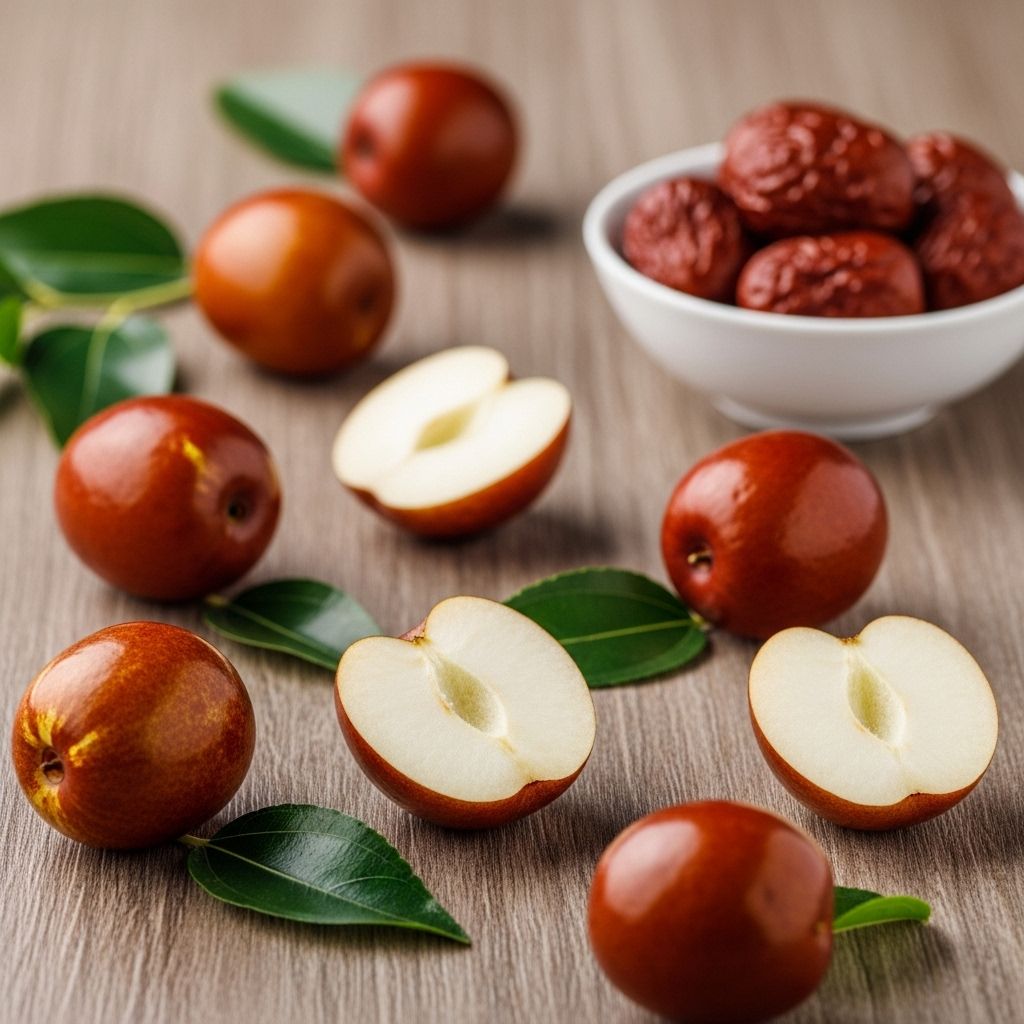Everything You Need to Know About Jujube Fruit: History, Nutrition, Benefits, and Uses
Discover jujube fruit: its fascinating history, exceptional nutrition, health benefits, and versatile uses for your kitchen and garden.

Everything You Need to Know About Jujube Fruit
Jujube fruit, also known as Chinese date, is a centuries-old staple in traditional medicine and cuisine across Asia. Prized for its nutritional value, health advantages, and culinary flexibility, jujubes are now gaining popularity worldwide. Whether you’re curious about trying this superfood, growing it in your backyard, or cooking with it, this comprehensive guide will cover its history, nutrition, health benefits, how to eat and store it, plus suggestions for delicious jujube recipes.
What Is Jujube Fruit?
Jujube fruit (Ziziphus jujuba) is a small, sweet drupe that originates in China, where cultivation dates back over 4000 years. It’s also commonly called “Chinese date.” Its fruits typically range from cherry-size to plum-size, with thin edible skins stretching over sweet, crisp, apple-like flesh. This fruit is now enjoyed fresh, dried, or cooked in various dishes and is valued both for its flavor and reputed wellness benefits.
Jujube trees are adaptable, hardy, and thrive in hot, dry climates, making them perfect for arid regions.
Their resilience and ornamental value have led them to be cultivated far beyond Asia, including the U.S., Mediterranean regions, and Australia.
Jujubes are valued for more than their flavor; their reputation for medicinal value has lasted for centuries in different cultures.
- Other common names: Chinese date, red date, tsao, ber (in India)
- Appearance: Round or oval, green when unripe; ripening to yellow-green with mahogany spots, then fully brown/red; can wrinkle when dried
- Flavor and texture: Crisp and apple-like when fresh; sweet, chewy, and date-like when dried
A Brief History of Jujube Fruit
The cultivation of jujube fruit began in China over 4000 years ago. From there, it spread through Asia, the Middle East, Europe, and North Africa. Its resilience to drought and temperature extremes made it suitable for a range of climates. The United States saw its first introduction of jujube trees in the 19th century, with improved Chinese cultivars arriving in the early 20th century. Jujube fruit has been used in folk remedies, snacks, and ceremonial foods for generations, earning a reputation as a symbol of good fortune and vitality in Chinese culture.
Today, jujube varieties are grown worldwide for their fruit, shade, and decorative value.
- Origin: China; cultivated for thousands of years
- Spread: Throughout Asia, Middle East, Mediterranean, North Africa, and U.S.
- Historic uses: Food, medicine, ceremonial offerings
- Symbolism: Prosperity, fertility, and longevity in Chinese tradition
What Does Jujube Fruit Taste Like?
To the uninitiated, fresh jujube fruit tastes remarkably similar to a sweet, crisp apple with subtle floral notes. As the fruit dries, it darkens and wrinkles, developing a chewy, date-like texture and richer sweetness. Both stages are edible, each offering a unique culinary experience.
| Stage | Appearance | Flavor | Texture |
|---|---|---|---|
| Unripe | Green | Mildly sweet, tart | Crisp, apple-like |
| Ripe (fresh) | Yellow-green to reddish-brown | Sweet, mild, aromatic | Crisp, juicy |
| Dried | Brown, wrinkled | Sweet, caramel-like | Chewy, dense |
Most people enjoy jujube in its crisp, fresh stage or as a naturally sweet, dried snack reminiscent of dates or figs.
Jujube Fruit Nutrition Facts
Jujube fruit is celebrated as a nutritional powerhouse. It is rich in essential vitamins, minerals, and beneficial plant compounds, providing both nourishment and wellness support.
- High in vitamin C: Supports immune system and skin health
- Contains vitamin B-complex: Vital for energy production and metabolism
- Rich in potassium: Supports heart health and blood pressure regulation
- Loaded with antioxidants: Flavonoids, polysaccharides, and phenolics protect cells
- Excellent source of dietary fiber: Promotes digestive health
- Low calorie: About 79 calories per 100 grams (fresh)
Detailed Nutritional Table (per 100g fresh jujube)
| Nutrient | Amount |
|---|---|
| Calories | ~79 kcal |
| Carbohydrates | 20 g |
| Sugars | 10 g |
| Dietary Fiber | 6 g |
| Vitamin C | ~70 mg (~77% DV) |
| Potassium | 250 mg |
| Protein | 1 g |
| Fat | <0.2 g |
Health Benefits of Jujube Fruit
Centuries of traditional medicine have emphasized the health benefits of jujube fruit. Modern research confirms many of these advantages, making jujube a top choice for anyone interested in boosting overall wellness.
- Immune system support: High vitamin C content fortifies natural defenses
- Antioxidant protection: Protects against oxidative stress and cellular damage
- Blood sugar regulation: Low glycemic index, suitable for diabetes-friendly diets
- Heart health: Potassium and flavonoids help lower blood pressure and cholesterol
- Digestive wellness: Abundant fiber enhances gut health and regularity
- Calming and sleep-inducing compounds: May improve relaxation and sleep quality
- Skin health: Vitamin C and antioxidants contribute to radiant, healthy skin
How to Eat Jujube Fruit
Jujube fruit is incredibly versatile and can be enjoyed in numerous ways:
- Fresh: Wash and eat the crisp, ripe fruit as a snack or add to salads
- Dried: Use as a natural sweetener, in trail mixes, or as an alternative to dates and figs
- Cooked: Incorporate into jams, fruit butters, compotes, or dessert bars
- Baked: Add to cookies, cakes, or bread for extra sweetness
- Brewed: Use in teas (jujube tea is soothing and popular in Asia)
- Stuffed: Cut open and fill the center with nuts or cheese for an elegant appetizer
Tips for Harvesting, Cleaning, and Storing
- Harvesting: Use a tarp beneath a tree and gently shake/knock fruit down. Pick when the fruit is half-green/half-brown or fully brown, before it wrinkles for the crispest texture.
- Cleaning: Rinse fruits in clean water, swirl to remove dust, dry on towels in shade.
- Storing: Refrigerate fresh jujube (vegetable drawer) for up to six months. Dried fruit stores well for longer.
Jujube Fruit vs. Dates
| Aspect | Jujube | Date |
|---|---|---|
| Botanical family | Rhamnaceae | Arecaceae |
| Texture (fresh) | Crisp, like apple | Softer, caramel-like |
| Texture (dried) | Chewy, dense | Sticky, soft |
| Sugar content | Moderate | High |
| Nutrition | Vitamin C, potassium, fiber | Potassium, fiber, iron |
How to Grow Jujube Fruit
Jujube trees are well-suited to backyard orchards, especially in hot, sunny locations. Their drought resistance and low maintenance requirements make them ideal for gardeners in arid or variable climates.
- Location: Full sun is essential. Plant away from shade for best fruit set.
- Soil: Prefers well-drained, sandy soil; tolerates salinity and alkalinity. Amend acidic soils with lime if needed.
- Planting: Place graft union above soil level. Dig hole twice the root ball size. Space trees 10-15 feet apart.
- Water: Extremely drought-tolerant once established, but benefits from regular watering during fruit development or extended drought.
- Fertilizer: Light applications of balanced fertilizer (5-10-10 NPK) every couple of months during growing season can help, but not strictly necessary.
- Pruning: Minimal; prune in winter to remove dead wood and open up canopy. Monitor root suckers and remove as needed.
- Pollination: Most varieties are self-fertile, but some benefit from cross-pollination for higher yields.
- Harvest: Fruits start to appear within 2–3 years of planting; mature yield after 4–5 years.
Popular Culinary Uses & Recipe Ideas
Jujube’s versatile flavor adapts well to sweet and savory recipes. Here are a few ideas to inspire your use of jujube fruit:
- Jujube Tea: Slice dried or fresh jujubes and simmer in water for a fragrant, relaxing herbal tea.
- Stuffed Jujubes: Pit fresh or dried fruit, fill with a walnut, pecan, or chunk of cheese, and dust with powdered sugar or drizzle with honey.
- Jujube Paste: Cook, pit, and blend fruit into a smooth paste for use in sauces, fruit leather, or jams. Sweeten to taste.
- Cakes & Cookies: Chop dried jujubes and add to batter as a natural sweetener.
- Salads: Add sliced fresh jujube for crunch and sweetness.
- Compotes & Chutneys: Cook jujubes with apples, pears, or citrus for creative condiments.
Frequently Asked Questions (FAQs)
Q: Are jujube fruits good for you?
A: Yes, they contain vitamin C, antioxidants, potassium, and beneficial fiber, supporting immunity, heart health, and digestion.
Q: Can you eat jujube seeds?
A: No, jujube seeds are not typically eaten. Remove the pit before eating or using jujube fruit in recipes.
Q: How do you know when jujube fruit is ripe?
A: Ripe jujube is often half-green, half-brown or fully reddish-brown but still firm and crisp. It turns wrinkled when dried.
Q: How should jujube fruit be stored?
A: Fresh jujubes keep for months in the refrigerator’s vegetable drawer. Dried jujube lasts even longer in a cool, dry place.
Q: Can jujube grow in my region?
A: Jujube trees are adaptable and can grow in a wide range of climates, as long as they receive full sun and are planted in well-drained soil.
Final Thoughts on Jujube Fruit
With a fascinating history, impressive nutritional profile, and culinary versatility, jujube fruit stands out as a truly unique superfood. Its ability to thrive in challenging climates and its suitability for sweet or savory dishes makes it an excellent choice for home gardens, healthy snacking, and creative cooking.
Whether you’re an adventurous eater or looking for a new fruit to cultivate, jujube offers both tradition and modern health appeal.
Read full bio of Sneha Tete












